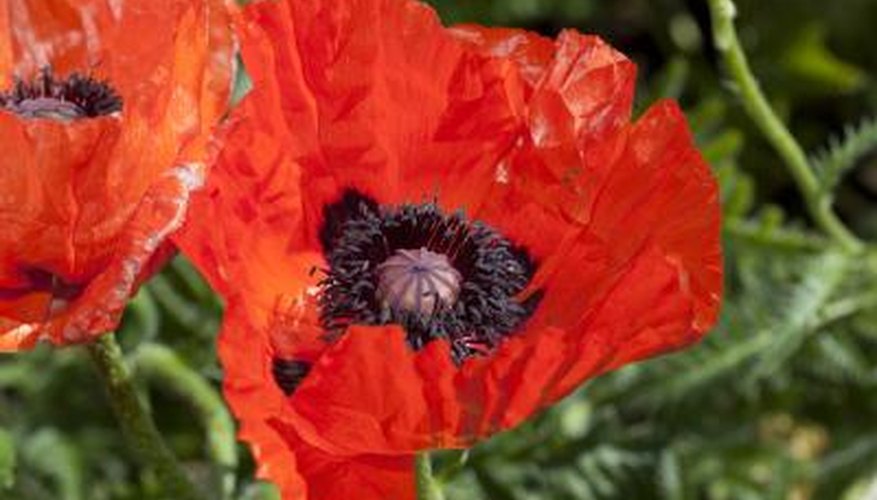Poppy flowers consist of several parts, and each part serves a purpose for the plant. These parts are all very distinct within a poppy flower, making them simple to examine and identify. The sepals protect the unopened flower bud. Once opened, the petals provide attraction and direction for pollinators that fertilise the flower. The centre of the plant holds the flower's male and female portions, which are essential for reproduction.
Sepals
The sepals connect to the base of the flowers and cover the immature buds. In most flowers the sepals are a ring of tiny modified leaves that primarily serve as both a protective coat for the immature flower and a support for the open flower. Once the sepals of poppy flowers open and the flower emerges, however, they are no longer required and fall off. As the flower opens, the sepals detach from the base of the flower and split open, eventually falling away to reveal the flower within.
- The sepals connect to the base of the flowers and cover the immature buds.
- In most flowers the sepals are a ring of tiny modified leaves that primarily serve as both a protective coat for the immature flower and a support for the open flower.
Petals
The petals are thin, leafy tabs that grow from the base of the flower between the sepals and the other inner parts of the flower. When the flower is ready for fertilisation, the petals open to reveal both the male and female parts of the plant. The petals produce sweet nectar to attract insects, and the petals' colouring helps to direct the insects into the flower to pollinate the plant.
Stamens
The male portions of the plant are referred to as the stamens. These are long, slender projections that form around the base of the flower, just within the petals. At the end of each stamen is a part called an anther. The anthers manufacture pollen, the male sperm. The pollen fertilises the seeds when it comes in contact with the female portion of the flower.
- The male portions of the plant are referred to as the stamens.
- The pollen fertilises the seeds when it comes in contact with the female portion of the flower.
Pistil
The pistil comprises the female portion of the poppy flower. The ovary, which connects to the flower's base, holds immature seeds waiting to be fertilised. Above the ovary, the stigma is rough and has a sticky surface that can capture pollen from the anthers and direct pollen grains to fertilise the seeds in the ovary. While many plant species also have a narrow neck that extends from the stigma to the ovary, it is conspicuously absent in the poppy.
- The pistil comprises the female portion of the poppy flower.
- Above the ovary, the stigma is rough and has a sticky surface that can capture pollen from the anthers and direct pollen grains to fertilise the seeds in the ovary.
